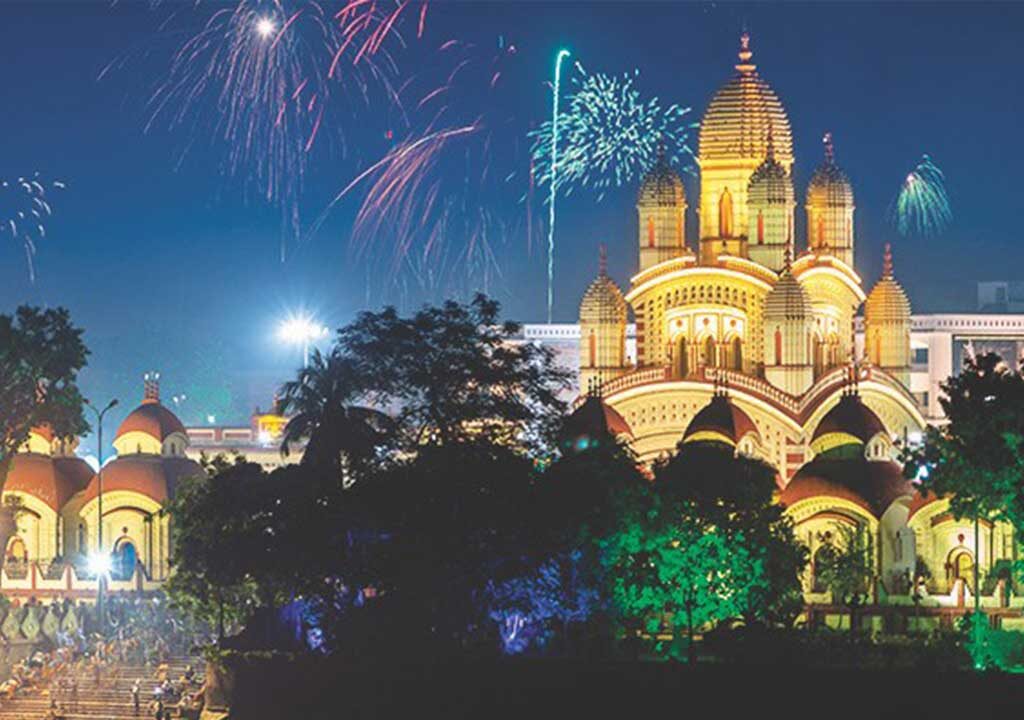Kali is the presiding deity of the city of Kolkata and the magnificent Kali temple at Dakshineswar along the banks of the holy river Ganges is one of the most enduring pilgrimage site of this incredible city. The sheer enormity of the temple premises invokes a sense of being overwhelmed with a rare spiritual zest whatever time of the day, month or year you visit this temple.
Every Tuesdays and Saturdays, which are considered particularly auspicious, a sea of humanity converges at the Dakshineswar Kali Temple. Young and old alike come from far and near to pay obeisance to the all-powerful goddess Kali as well as to pay respect to one of modern India’s most venerated Hindu spiritual messiah – Sri Ramakrishna Paramahansa. The air of spiritual zest reaches its crescendo during the annual Kali Puja or “Diwali”, which is generally celebrated in the month of September-October just after the all-important Durga Puja – the biggest religious celebration of Bengalis.
To Calcuttans, Dakshineswar Mandir is an integral part of the city’s folklore. The nine-spired main temple is surrounded by a huge courtyard along with 12 miniature Shiva temples (Jyotirlingas) as well as a temple dedicated to Radha Krishna. The holy river Ganges kisses the temple’s outer premises and there are two exclusive bathing ghats where most pilgrims and devotees take the holy dip before offering their obeisance to mother goddess Kali or “Bhabatarini” and Lord Sri Ramakrishna Paramahansa, who spent a considerable amount of his time as a priest of this magnificent temple.
The temple has quite a bit of history attached to it. Legend has it that in the year 1847, a wealthy widow of a Bengali Zaminder – Rani Rasmoni made up her mind to go on a pilgrimage to the holy city of Banaras, which is quite a distance from Calcutta, given the fact that in those days Rani Rasmoni choose to travel by boat, 24 in all, accompanied by her friends and relatives to Banaras. However, on the penultimate night of her departure to Banaras, Rani was blessed with a dream in which mother goddess Kali (Bhabatarini) appeared before her and advised her not to proceed to Banaras. Instead, the goddess directed her to build a temple dedicated to her and install an image in which she would manifest herself and accept the prayers of the suffering humanity. And the rest as we all know is history.
Once the temple was built and it took almost 8 years (1847 –1855), Sri Ramakrishna Paramahansa was given the task of the head priest of the temple after the demise of his elder brother Ramkumar. For the next 30 years of his life, Sri Ramakrishna not only performed the task of a head priest but also immersed in deep spiritual practices at this temple. It is here that Sri Ramakrishna’s spiritual zest began to bloom and some of the most epoch making events of modern India’s spiritual regeneration found its expression at this stupendous temple. From the arrival of Narendranath to his ultimate transformation as Swami Vivekananda on the world stage, the doctrine of harmony of religions and the subsequent flowering of the Ramakrishna Math & Mission into the forefront of the world’s spiritual and philanthropic landscape are all rooted in the Dakshineswar Kali Temple.
Sri Ramakrishna Paramahansa is considered as an incarnation of God and he practiced the different religious beliefs like Vaishnavism, Shaktism, Vedantism and Tantrikism. He happens to be the only Indian sage, from ancient to the present, who achieved the ultimate spiritual enlightenment – “Nirvana” through the Devi Sutra in Hindu, the Allah of the Mohammedans and Jesus Christ of the Christians. The culmination of an uneducated and poor Gadadhar Chattopadhyay from a remote village of Bengal’s Kamarpukur to the highest order of spiritual wisdom have all occurred in the backdrop of the holy Dakshineswar temple.
Apart from the main Kali temple, visitors to the temple also make it a point to visit the hallowed dwelling chamber of Sri Ramakrishna located to the northwestern side of the temple premises in close proximity to the last of the Shiva temples. In this chamber there are two beds used by Sri Ramakrishna where his photographic images are installed and ritual pujas are performed everyday by the temple priest. A glass enclosure separates Sri Ramakrishna’s beds from the visitors. In the evening, in time for the all-important Aarati, a Hookah pipe is attached to Sri Ramakrishna’s image and doesn’t he seem to be in a trance piping that Hookah?
Such is the fervor of the devotees that they believe, the ‘Master’ is very much present in not only his chamber but everywhere else around the temple. There are authentic reports of numerous devotees who have been blessed with his divine presence at the Dakshineswar Kali Temple. There is a popular belief that every month during “Amabaishya” evening if one sits on the steps of the bathing ghat opposite to the main temple, one is likely to hear the footsteps of the ‘Master’ as he rises from the holy river Ganges and walks all the way to the main temple wearing only his loin cloth and “Kharam” or wooden slippers.
The main temple is conspicuous by a magnificent “Natmandir”, or music hall, which is well supported by regally done up pillars. To the northwest and southwest parts of the temple premises there are two “Nahabats” or music towers. The elaborate planning of the temple premises with its paved courtyard has a number of rooms exclusively meant for use by the staff and guests of the temple.
Of special importance is the orchard to the north of the temple premises where the “Panchavati” consisting of the Banyan tree and the Bel tree, associated integrally with Sri Ramakrishna’s spiritual practices where he would sit in meditation for hours together. Presently the entire Panchavati area and its surroundings have been remodeled with an ethnically designed hut, the kind found mostly in the villages of Kamarpukur and Jayrambati where Sri Ramakrishna and his holy consort Sri Sarada Devi belonged. Apart from the Panchavati, the dwelling place of Sri Sarada Devi – “Nahabat” which is a double storied edifice has been remodeled by architects and restored to its former glory. On the ground floor, the image of Holy Mother is ritually worshipped everyday by the temple’s priest.
The piece de resistance is of course the sanctum sanatorium of the Divine Mother – “Bhavatarini”, the dispeller of darkness. The basalt image of the mother goddess Kali is conspicuous by her dazzling gold brocade, and she is seen standing upright over the white marbled image of her holy consort Shiva who lies prostrate below her. The Divine Mother is adorned with the choicest of ornaments like anklets, necklaces made of gold and pearls, a garland of human heads made out of gold and a golden nose ring with a pearl-drop.
It is here at this world famous Kali Temple of Dakshineswar that Sri Ramakrishna observed some of the most difficult and path breaking “Sadhanas” or spiritual austerities. His bitter lamentations to the divine mother to reveal herself, his daredevil decision to end his life unless blessed with her vision, his constant lingering for religious truth and the remarkable ease with which he attained the pinnacle of spirituality glory or “Moksha” is today a part and parcel of Bengal’s popular folklore.
Today as the world progresses at a phenomenal pace, the key concepts of Sri Ramakrishna’s teachings like the oneness of existence, the inherent divinity in all living beings and the harmony of religions is being felt eagerly with each passing day. After his passing away, Sri Ramakrishna’s message of universal harmony of religions was spread all over the world, particularly in the affluent western countries like USA and UK by his foremost disciple Swami Vivekananda. His soul stirring lectures were rousing calls to a sleeping giant,

in the West they were bombshells, not meant to awaken an ancient culture, but to turn a relatively young one upside down. He stirred those countries to the very bottom of their and galvanized the entire world with his historic and epoch making speech at the World Parliament of Religions at Chicago in the year 1893.
The spiritual saga of the Dakshineswar Temple is such that even today devotees from aflluent western countries come here in ever increasing numbers just to feel the surcharged spiritual energy that oozes here. There are some who pay a visit every year during auspicious occasions like the birthday of Sri Ramakrishna, Holy Mother Sarada Devi and Swami Vivekananda and his brother disciples.
I meet one ardent devotee of Sri Ramakrishna – Anne Gower from U.K. who visits the Dakshineswar Temple every year for spiritual solace and according to her – “the vision of the Mother is exciting attention today when for the first time in history we have so many single parents battling for survival in their profession, battling traffic to get home at the end of the day, battling to feed their kids and keep their houses reasonably sane and to them the concept of an all-powerful Mother deity who all alone creates and sustains this universe begins to feel right”.
If Dakshineswar Kali Temple was the playground of Sri Ramakrishna’s “Leela”, Belur Math – the worldwide headquarters of the Ramakrishna Math & Mission located on the opposite bank of the river Ganges is the place where the Master’s teachings and doctrines have been put into practice. It goes without saying that most visitors to Dakshineswar Kali temple compliment their visit to the Kali temple with a visit to Belur Math. There are regular ferryboat services linking the Dakshineswar Kali temple with Belur Math and vice versa.
Offering puja at Dakshineswar is a lot saner than the sheer chaotic situation of Kalighat, another of Calcutta’s renowned Kali temples. The best part is that however big the crowd, one and all have to advance through the queue, however serpentine it might be. During festive occassions and on weekdays like Tuesdays and Saturdays along with “Amabaishyas” the crowds descend from all over Calcutta and beyond and even then there is order in place. Here the “Panda-nuisance” (Touts) that are customary in other pilgrim places are never an issue.
On prior information, the temple’s Management also provides exclusive services to outstation pilgrims by attaching a registered “Purohit” or priest who performs the all-important puja with the necessary offerings to the mother goddess like sweets, flowers, incense sticks and other associated worshipping accessories that can be bought from the adjacent “Dala Arcade” flower market.
There is also the popular belief among the rich and the wealthy of Calcutta and elsewhere that providing “Kangali Bhojons” or feeding the poor at Dakshineswar brings divine blessings from the goddess and the temple’s management does make arrangements for such philanthropic gestures of generosity towards the poor.
Here at the Dakshineswar Kali Temple Sri Ramakrishna’s mystical experiences assure us that the Mother goddess indeed functions in the lives of her devotees as protector and companion. What is important for us, the lay devotees is that the ability to “catch” the all-powerful Goddess for ourselves in our own vision is open to us if we actually want to reach out for it.
Traveler’s Fact File:
Dakshineswar Kali temple is located to the left of Dunlop Junction, and further ahead is the P.W.D Road that extends all the way to the Dakshineshwar Railway Station. You need to take a left turn after crossing the railway station that leads you to the Temple. A new flyover has been built that conveniently links the Dakshineswar temple to Calcutta proper. Hired taxis ply regularly from the NSCB airport, Sealdah Railway Station and Howrah Railway Station making Dakshineswar Temple within easy reach of visitors.
TRIVIA BOX – I:
In one of Narendranath’s (Swami Vivekananda’s) visit to Sri Ramakrishna at the temple of Dakshineswar, the ‘Master’ ushered Narendra to his bedside at his hallowed chamber. Sri Ramakrishna was lost in his Divine mood and as he gradually approached Narendra, he touched him with his right foot and the corresponding spiritual fervor experienced by Narendra was summarily described by Swami Vivekananda thus – “I saw with my eyes open that all the things of the room together with the walls were rapidly whirling and receding into an unknown region, and my I-ness together with the whole universe was, as it were, going to vanish in an all devouring great void. I was then overwhelmed with terrible fear. I knew that the destruction of I-ness was death, so I thought that death was before me, very near at hand. Unable to control myself, I cried out loudly, saying, ‘Ah! What is it you have done to me? I have my parents, you know.'”
TRIVIA BOX – II:
During the time when Sri Ramakrishna was at the height of his spiritual austerities at the Dakshineswar Kali temple, many people from his ancestral village of Kamarpukur were of the opinion that Sri Ramakrishna had gone mad due to the rigors of his spiritual austerities. Even after being married to Sri Sarada Devi, whom he left behind at his ancestral village, he carried on with his “Sadhana” at Dakshineswar and people of the village began taunting Sri Sarada Devi that her husband was indeed mad.
Alarmed, by the fact that her husband might have gone mad, Sri Sarada Devi decided to pay a visit to Dakshineswar herslf to find out the true story. To her utter delight she found out that her holy consort – Sri Ramakrishna was every bit a normal individual. After her first visit to Dakshineswar, she once again returned to her ancestral village only to come back and stay permanently with Sri Ramakrishna at Dakshineswar’s Nahabat.
TRIVIA BOX III:
Holy Mother in the most unique way fulfilled the duties of a wife, mother and nun. There have been before in the world the ideal wife, the ideal mother and the ideal nun, but a combination of the three in one person is rare indeed. She was his companion in spiritual life. In spite of her marriage she remained a nun, pure in body and mind and in uninterrupted communion with god. Though she had no children of the flesh, she had many of the spirit.
There was an instance when Sri Sarada Devi was massaging Sri Ramakrishna’s feet and she suddenly asked him – How do you look upon me? Sri Ramakrishna’s reply was – “The Mother who is in the temple, the Mother who has given birth to this body and is now living in the Nahabat, the same Mother is now massaging my feet. Truly, I always look upon you as a form of the blissful Divine Mother”.




![[ India Today ] Ohio senator JD Vance thanks wife, a Hindu, for helping him find Christian faith](https://hinduvishwa.org/wp-content/uploads/2024/06/us-senator-jd-vance-reveals-how-his-hindu-wife-usha-helped-him-find-his-christian-faith-image-re-272530504-16x9_0-120x86.webp)










